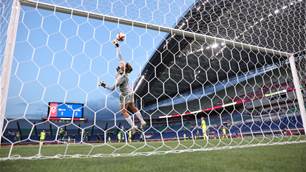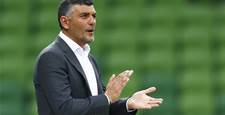IN 2004, Leeds were relegated from the Premier League after borrowing, spending and not performing. Now, Liverpool could face the same fate…
When, aged 62, Roy Hodgson was finally handed his dream job this summer - "the biggest in club football," he said of Liverpool, and he's been around a bit - his immediate tasks were more about salvage than success. This was not a Bob Paisley moment, a modest, self-effacing football man taking over an Anfield operation engineered by Bill Shankly to reign supreme for years, as Liverpool went on to do under Paisley, winning six League Championships and three European Cups between 1974 and 1983.
Hodgson's arrival was more reminiscent of Shankly's own, who in 1959 faced a restoration job at a spent, exhausted club - although Liverpool then were mired in the Second Division, not feeling they are in crisis because they finished seventh in the Premier League. Yet this was truly a modern crisis for Liverpool, on a scale which would surely have appalled even the indomitable Shankly. Bank debts alone, at a club famous for prudence approaching tight-fistedness, had mushroomed to £250m ($418m). The bulk of that had been directly loaded onto the club to pay the borrowings the American owners, Tom Hicks and George Gillett, took on when they bought the club in February 2007.
The pair arrived promising to relaunch Liverpool to the glories Shankly and his boot room successors delivered, but instead they left a trail of debt and broken dreams. Their vow then, to build Liverpool the long-mooted new stadium in neighbouring Stanley Park, produced grand designs but barely a sod of earth overturned. Rather than funding Liverpool to where they were in the 1970s and 1980s, the spectre began to loom instead of Leeds United in the early 2000s, over-borrowed and at risk of collapse. The auditors, KPMG, commented alarmingly on the club's financial accounts in 2008 and 2009 that the short-term loans to the club from Royal Bank of Scotland and Wachovia "may cast significant doubt on the group's and parent company's ability to continue as a going concern".
Leeds, in the infamous admission of the then chairman Peter Ridsdale, had at least spent their borrowings "living the dream", reaching the Champions League semi-final before plunging into football and financial collapse. Liverpool won the Champions League on that wondrous Istanbul night in 2005, and reached the final in 2007 with Hicks and Gillett only months in the Anfield boardroom. Since then, the pair have loaned money in - £144m ($240m) by this year - to buy Fernando Torres and provide Rafael Benitez with a significant transfer fund which few argue the manager spent wisely. Yet in the summer of 2009, after Liverpool finished second in the Premier League, Benitez spent £20m ($33m) on Alberto Aquilani, from Roma, and a remarkable £18m ($30m) for Glen Johnson from penniless Portsmouth, adding up to not much more than he received for selling his world-class midfield anchor Xabi Alonso to Real Madrid for £30m ($50m), Alvaro Arbeloa, also to the Bernabeu, for £3.5m ($5.8m), and disposing of other squad players.
Liverpool finished seventh last season, crucially dropping out of the Champions League that earned them vital credibility and cash: £23m ($38m) from television alone in 2008 when they reached the semi-final; £19m ($31m) in 2009 when they were knocked out in the quarters.
In April, Hicks and Gillett - who had first tried to soldier on, then searched the world for new investors - finally accepted, under pressure from the banks, that they had to sell outright, and appointed a new chairman, Martin Broughton, to reel in a buyer.
The great Liverpool Football Club limped into this summer up for sale, their very existence financially uncertain, staring at a season with no Champions League football and that vital tranche of income lost, key players questioning seriously whether they wanted to stay, and supporters in open rebellion against the owners. Hicks and Gillett denied the club was in serious financial risk, and Broughton maintained they did not have to sell Torres or other players to pay off debt. But the power lay with decisions made in bank headquarters, not at the Melwood training ground.
Rogan Taylor, a lifelong Liverpool fan and long-term campaigner for supporters' rights, is a director of Share Liverpool, a supporters trust formed to raise £50m ($83m) to buy an immovable 10 per cent stake in the club, and play a part reflecting the views of fans in the club's running.
"Sadly it has become palpably clear over the last three years that the decision to sell the club to Hicks and Gillett was about the most disastrous in the club's 118-year history," he argues. "We had very little debt before, the new stadium could have been financed in a straightforward way, but instead we became a sinking ship, in an ocean of debt, waiting for another passing billionaire to bail us out. As Liverpool supporters, we could never have foreseen the club being in this state."
So Hodgson's first days in the Anfield manager's office, the pinnacle of his remarkable football journey from non-league player at clubs like Gravesend & Northfleet and Maidstone United in the 1970s, were spent trying to convince his elite stars, Steven Gerrard, Fernando Torres and Javier Mascherano, that there could be a worthwhile future at Liverpool. Keenly aware of how greatly the team relied upon Gerrard and Torres, and that such players see Champions League football as their natural milieu, not a prize to be fought for, Hodgson's immediate job constituted a charm offensive.
"I'll be trying to persuade them that this is the place to be," he said. "I'll ask them to give me a chance, to work with you, and to improve on last season."
Continued on next page...
Related Articles

Postecoglou looking to A-League to 'develop young talent'
.jpeg&h=172&w=306&c=1&s=1)
Big change set to give Socceroos star new lease on life in the EPL












